The Neverending Story was a classic children’s fantasy of the 1980s, right up there with The Dark Crystal, Labyrinth, Legend, and The Last Unicorn in creating a latticework of terrifying puppets, questionable animation, and traumatizing storylines. It had an added allure for this small, library-loving nerd: it was about a book that never ended. Most fantasies just give you a perfunctory review of some scrolls or an ancient dusty text before galloping back into an action scene, but The Neverending Story is literally about a kid sitting in an attic and reading all day—making it both fantasy and Carverian realism as far as I was concerned.
Looking back at it as an adult (more or less), I was surprised by how well it holds up. True, you have to look past some extremely…emphatic acting, and Falkor is slightly creepy now that I’m older (although compared to David Bowie’s tights and Molly Grue’s lamentation for her virginity lost youth, he’s really not that bad), but most importantly, watching it now gave me a completely different experience, not just an exercise in nostalgia.
Here are 9 reasons you should revisit it, too:
1. Nostalgia
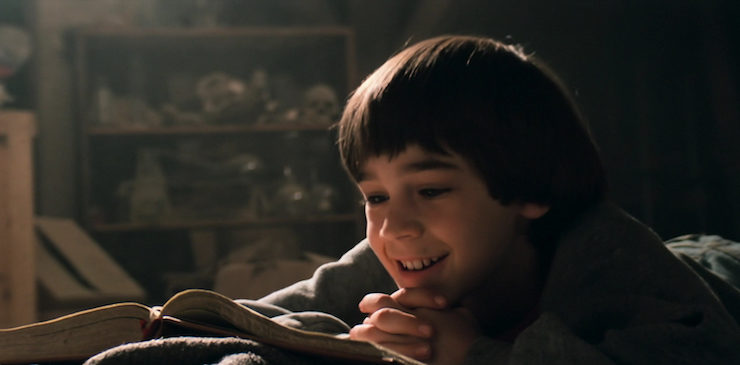
Let’s just get this one out of the way. Being a kid sucks most of the time. You have very little agency, you’re bound by rules you don’t always understand, you often have to eat things that you hate, and there’s usually at least some amount of homework. If you were anything like me, the best days of your childhood were most likely spent huddled under a blanket, reading something—The Hobbit, Earthsea, Harry Potter, Ender’s Game—that took you somewhere else, somewhere where you were definitely not a kid, or at least you had some compensatory magical ability. The Neverending Story takes this memory and cranks the dial all the way up, adding a forgotten math test, a spooky attic, and a vicious thunderstorm to create the best possible environment for escapism.
2. The effects are fantastic!
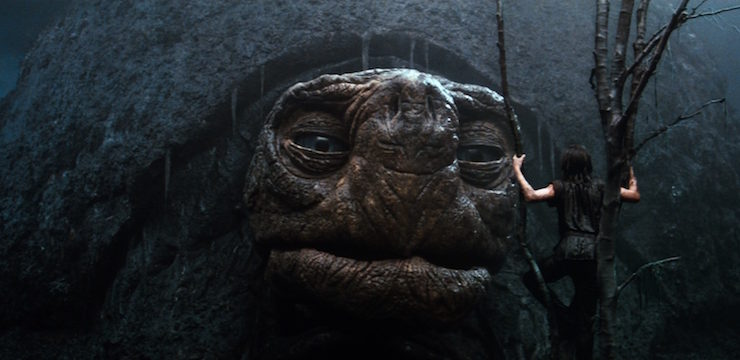
I mean, they’re not always good, and they don’t quite stand up to The Dark Crystal or other Henson work of that era, but they have a particular homemade flavor. Morla the Ancient One and the Rock Biter are expressive characters who come to life with only a few moments of screen time, and the council of advisors who summon Atreyu are all unique, rather than succumbing to the discount Mos Eisley Cantina feeling. The Neverending Story isn’t lifting imagery or ideas from Star Wars, E.T., Henson, or even something like Excalibur. Fantasia feels like a fully-realized, self-supporting world, and the movie is telling a story that, while drawing on archetypes and classic mythological themes, still gives you something new.
3. The Auryn
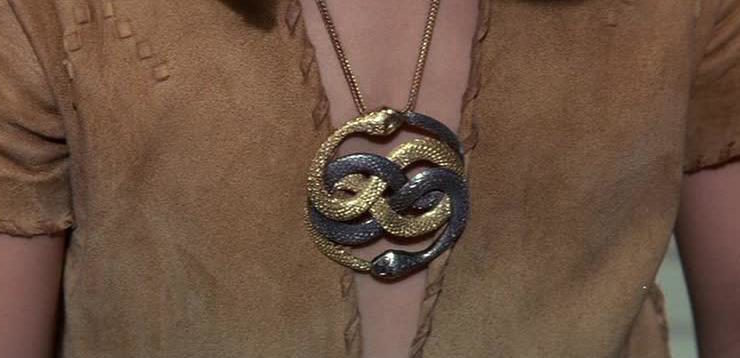
The Auryn is still the coolest piece of fantasy jewelry ever. It doesn’t need to be cast into a volcano, it won’t screw up any time streams, and it doesn’t require a piece of your soul. It simply functions as an elegant symbol of eternal return and interconnectedness, and occasionally mystically guides you to the Childlike Empress. No big deal.
4. Artax
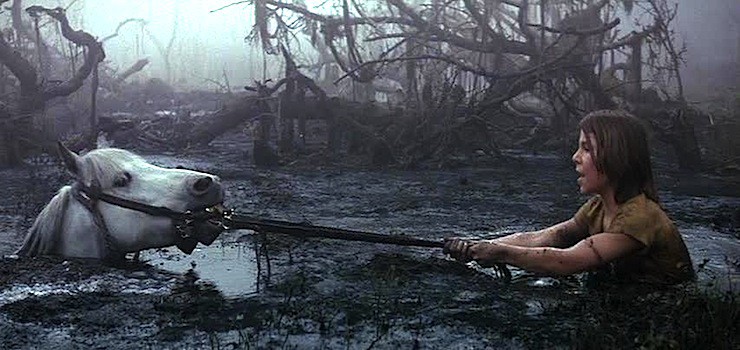
When you were a kid, Artax’s death was shattering. His death is real, and tragic. Yes, Artax does come back, but only because Bastian—who is just as devastated as the audience—wishes it. I don’t know about the rest of you, but I spent waaay too much time wondering if the Artax at the end was really the same Artax, if the newly-wished-into-existence horse would have the same memories as the original. And does he remember his death? (Like I said, maybe too much time spent on this…)
Watching The Neverending Story again as an adult is beneficial in a very specific way: You watch the horse die, it still hurts, and you remember that you’re not the hollowed-out shell of grown-up responsibility you sometimes fear you have become.
See? Helpful.
5. The Magic Mirror Gate is far more resonant now
To put it a better way, it probably didn’t make any sense at all when you were a kid, but now it will. As a kid, Engywook’s words of caution—“kind people find out that they are cruel. Brave men discover that they are really cowards! Confronted by their true selves, most men run away screaming!”—didn’t sound terribly scary, because they refer to a very adult type of self-doubt. Bastian and Atreyu are both confused by the Mirror—like the kids watching the film, they can’t understand why seeing your true self is so frightening. But what adult would be willing to look into it, and see that their self-image is false?
6. META-PALOOZA. META-GANZA. META-POCALYPSE!
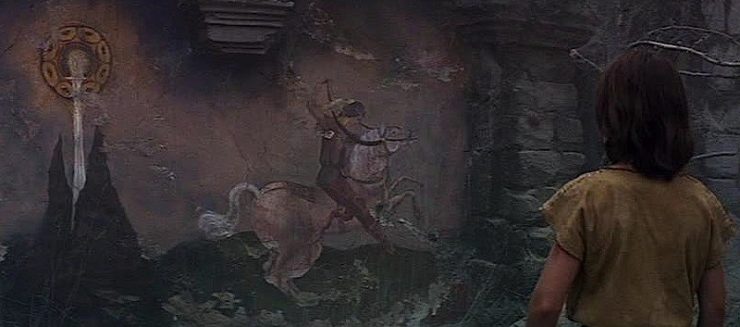
Now we throw the term “meta” around as carelessly as “hipster,” but The Neverending Story uses its nested story structure to illustrate a larger point. Atreyu is living his adventure as the hero, but he’s given hints that his life isn’t what he thinks it is. He sees Bastian in the Mirror Gate, hears Bastian scream when Morla first appears, sees his own story depicted in a series of narrative murals, and eventually is directly told by the Empress that Bastian has shared his adventure. Despite this, he never questions his quest. He carries on being a hero, even to the point of challenging Gmork to an unnecessary fight (more on that later) and dies in the Tower without ever realizing that he’s a fictional creation. He has a job to do, and anything beyond that job is irrelevant.
Bastian, meanwhile, also receives clues that he is more involved in the life of Fantasia than he realizes. He hears the Empress tell Atreyu that “others” are sharing Bastian’s adventures: “They were with him in the bookstore, they were with him when he took the book.” Bastian replies with a Hamill-worthy “But that’s impossible!!!” and carries on in his role of nerdy boy reading in an attic. He only truly flips his shit when the Empress addresses him directly to demand a new name. (More on that name in a second.) The movie deftly skips over that bit, and never returns to it, but think about it: those “others” are us, right? As in, the kids sitting on the floor in front of the TV watching the movie? If we’re watching Bastian, and he’s watching Atreyu, then who the hell is watching us?
Now, before we spin off into dorm room musings, I wanted to pull back and say that I don’t think the film was trying to convince us that we’re all in some reality TV show without our knowledge. But I do think they were trying to sneak in a comment about the way we construct our lives. How do we see ourselves? How do we choose our actions? If our lives were books or movies or six-issue mini-trades, what would we want them to look like? I would submit that you could do worse than this:
7. “If we’re about to die anyway, I’d rather die fighting”
On the one hand the fight with Gmork is Atreyu acting like a heroic automaton. But then there’s that other hand, and that other hand has an amazing moment in it. Think about it—it would be so much easier for Atreyu to give up. The Nothing is coming anyway, right? Gmork doesn’t recognize him, he’s done everything in his power to reach the Human Child—at this point no one could blame him for sitting back with the Rock Biter and waiting for the Nothing to take him.
Instead, he risks a painful death-by-combat with a giant wolf. That’s a hell of a way to rage against the dying of the light.
8. Bastian recreates the world from a grain of sand
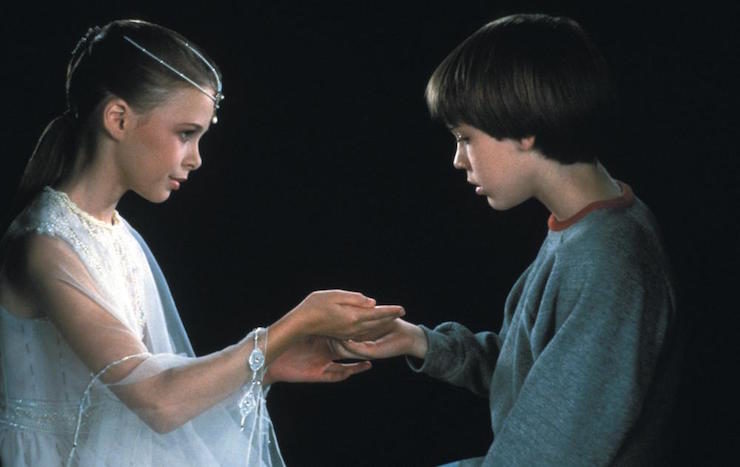
Blakean imagery aside, there’s a great lesson here—a lesson that’s far better for adults than kids. When you’re a kid it’s pretty easy to bounce back from failure and disappointment, because—unless you’re a Peanuts character—you just assume that the next time will go better, and you try again. But once you’re older, and you have a longer list of break-ups, dropped classes, books you haven’t finished reading, books you haven’t finished writing, plus maybe a layoff or two, it gets harder and harder to work up enthusiasm for new projects. Here we have a story where the world really ends, and all the characters we love die—Atreyu and Bastian have both failed. How often do you see a kid fail in a children’s movie? But that failure doesn’t mean that Bastian gets to fall apart and hide in the attic forever—he has to go back to work, and, ironically enough, do exactly what his father told him to do at the film’s beginning. Fantasia is his responsibility now, and he has to rebuild it and take care of it.
9. Follow Your Urge to Research!
As an adult watching this you can hear the name Moon Child and think, “what the hell? Did Bastian’s grandparents conceive during a Dead show?” Alternatively, you can look up the name Moon Child, and go off on a fabulous Wiki-wormhole leading to Aleister Crowley and the history of 20th Century Magick, which is just fun. But even better, you could dive into the work of The Neverending Story’s author, Michael Ende. Ende was one of most beloved children’s authors in Germany, and while not all of his books have been translated, it’s worth the effort to find them. The Neverending Story in particular is a fascinating deconstruction of fairy tales, much darker than the film, and one of the most rewarding books I’ve ever read.
You have all followed me on the adventure of revisiting this film. Now, in true Childlike Empress style, I am turning to you. I don’t need a new name, but I would like to now: did you love this movie when you were a kid, or were you more into…I don’t know…Inkheart? What are your go-to movies for adult-ennui-relief? I can always use a few more.
This article was originally published in August 2013, and appeared again in August 2016.
Leah Schnelbach has never quite managed to keep her feet on the ground, no matter how hard she tries.










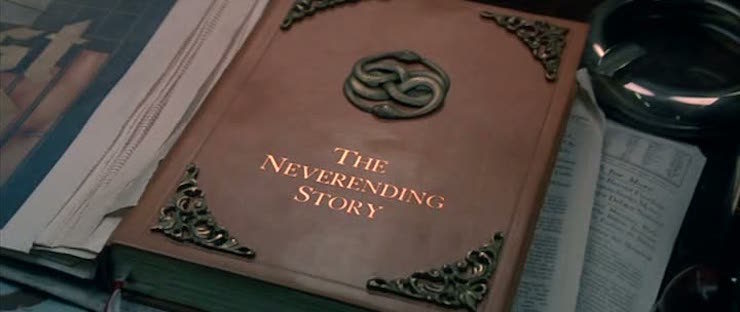
I just want to mention that, if you can find it, Momo by Michael Ende is another fantastic tale. I /might/ even like it better than the book of The Neverending Story and I adored that one!
And upon checking Amazon, I think Momo is about to be republished or just has been and there’s a Kindle edition, I AM SO EXCITED!
Watching this movie again recently, what took my breath away was just how scarily timely one part of the exchange between Gmork and Atreyu is in these parlous days.
When Atreyu asks Gmork why it is helping the Nothing to overcome Fantasia with despair and emptiness, Gmork replies:
“Because people who have no hopes are easy to control; and whoever has the control… has the power!”
I loved and hated this film as a child, which tells me I should definitely watch it again as an adult! I found Gmork terrifying, and it was so spooky that he was reading a book… But the characters knew, and he was part of the story. Nightmare material!
But I also must have watched it a hundred times, and loved Artax so much. Yes, time to find a copy of this (maybe our VHS is around somewhere??) and watch it again!
I first read the book before I saw the movie, I also had a tape with the story. I saw the beginning of the movie a few months ago and everything the narrator told was very familiar. It’s a sad story so I am not keen on watching it again. Especially Artax death, now that I have a horse myself.
Thanks for the article!
Thank you so much for the article. I totally agree with it. Funny that both NES and Legend have been reviewed on Tor in the last week as they are both 80’s classics and lifelong inspirations for me – don’t know what it is about 80’s fantasy like the other films you mentioned but despite the cheese they really capture that ephemeral, mythic feeling and well..magic, that I find later more polished works don’t seem to as much.
Too many things to count but here goes –
1) Archetypal journey/symbolism. People who might have seen my comments before might note Ive studied alot of Jungian Psychology, mythology and comparative religion. One of the main reasons I love fantasy is that I feel we are reading and creating our own myths, our own archetypal journeys when we get involved with the genre. No other story states this as explicitly as NES. Sure people get whisked away into a magical world or told they have magical powers etc but NES as you said literally weaves this into its narrative. The layer upon layer of symbolism between Reality and Fantasia, Bastion and Atreyu, US and Bastion – that by watching this story and taking its meaning into our own lives and other peoples in a way is why the Neverending Story IS the Neverending Story, complete with the Ouroboros talisman in the AURYN is just…wow. And when I went back to analyse it again a few years ago and look at the original story, it just gets better. I particularly love the interconnected nature of Reality and Fantasia – that what affects one, affects the other – and to save one, you need to cross over and save the other, symbolised by the two snakes. That the Empress can only be healed by being given a new name, the way stories and archetypes need to be reborn and keep being reborn to remain relevant. God and the commentary on the Nothing and the Mirror – amazing. I adore stories that can appeal to me on so many levels.
2) On that note – as @Russell H said – something that has always stuck with me and came back vividly in a time of struggle last year was Gmork’s line ‘People without dreams are easier to control…and whoever has the control, has the power!’ Shivers…and not just because its being said by a beast that STILL could give me nightmares (bloody wolves!). Not to get too ranty here but I really see the way mass media consumption and branding (having studied it alot recently) works to pacify many people who have been conditioned to give up their creative dreams and work in monotonous jobs they hate to serve an unhealthy and elitist economy so this really resonated.
3) God Artax…still upsets me now.
4) Setting and characters – I love the old school puppets and sets and I’m still trying to get hold of images of ‘the sea of possibilities’ section where Atreyu loses Falgor as inspiration for my own book.
5) FALGOR!!!!!!!
6) Never could hear the name he whispers – Moonchild wtf? But that image of them rebuilding the world from a grain of sand – loved it even before I got into Worldbuilding for a living.
7)Cheese – I love the theme, even if its annoying, 80’s and so cheesy you could bake it on a pizza.
Ps laughed so much at your discount Mos Eisley comment – so spot on! Some of those ambassadors in the Tower – the weird face people are just flat wrong.
Not that it matters… but yes.
This is well-timed – for those in the USA near one of the theaters that hosts these things, Fathom Events is playing The Neverending Story on the big screen September 4 and 7 (I’m not going to try to post the link but if you search Fathom Events it shouldn’t be hard to find). I’m super excited because while this was my most favorite of favorite movies as a child, I was young enough to never have seen it in a theater.
Wait, are you supposed to be able to understand the name Bastian yells into the storm?
I watched and rewatched that part over and over as a kid because I could never understand what he said. I thought the storm was supposed to drown out his voice.
If you can find them you shod absolutely read the Neverending Story and Momo. Somehow those books scared me far more as a kid than the Lord of the Rings ever did.
If you have small children you should absolutely check out Jim Knopf and Lukas. They are just amazing + for us Germans there is a great series of String Puppet shows – maybe they also got dubbed.
Additionally I would recommend Krabat by Ottfried Preussler(apparently the English title is “The Satanic Mill” which gives away far to much and is also a little misleading in my opinion) if you really like dark books for children. He is the other larger than life child book autor from my youth
I love the movie, rewatched it as an adult, but it has been a few years now, maybe it´s time for another rewatch. The book on the other way… well, it is fantastic, but I just never liked Bastian. The story starts with him stealing a book, and as a librarian I really do not approve that sort of thing. He´s even more unpleasant in second part of the book (and the sequel movie).
When I thought of a book I could recommend, I realized – Neverending story is really unique, isn´t it? It is hard to think of a similar or similarly awesome book. Only author that comes to my mind is Walter Moers – The City od Dreaming Books is almost too fantastical (and I usually say: the more fantastical, the better) – and sooo full of books.
There is also completely different, but worth mentioning and often overlooked trilogy by Italo Calvino. It is just “sort of” trilogy, and the three parts are: The Nonexistent Knight, The Cloven Viscount and The Baron in the Trees. They all have this “classic book” feel to them, like Jungle Books or Treasure Island or so, and are just mildly fantastical in their own strange way. Discovered this gem as an adult: always wished I knew it as a kid.
Good to hear that I’m not the only one for whom the Mirror scene made absolutely no sense as a child. That scene stuck in my head all through my childhood because I loved the tinkly piano music that goes with it, and it made absolutely no sense whatsover. I always thought as a child that if I could figure out how to play that music on the piano that the scene would magically make sense.
Growing up is what made that scene make sense.
This is such a perfect movie in every way!!
It occurs to me that this is one of the few big cheesy 80s fantasy movies I don’t own yet. I should revisit it; I think part of the problem for me was the timing — when it came out, I was a bit too old to imprint on it the way I did on, e.g., Flash Gordon or the Harryhausen films, or even Dragonslayer.
If anyone finds themselves in Munich I encourage a visit to Bavaria Films Studio, where The Neverending Story was filmed.
You can even “ride” Falcor and watch yourself do it via a screen monitor.
Thanks for the article. I never thought I would revisit The Neverending Story but have added it to my list to see again.
Carl Kruse
Having grown up on this film as a child of the 80s, I tried to read the book in recent years and was forced to put it down midway through due to the Lost Highway-esque twist. But what I did read was very good.
Personally, I was never a big fan of the Neverending Story, but loved, and still love, Michael Ende’s The Night of Wishes. In my opinion it’s one of the best fantasy stories and certainly the best one to read or listen to at New Year’s Eve! As a child there was no New Year’s Eve without the audio version of that book (read by Michael Ende himself!).
I still know the German title of The Night of Wishes (Der satanarchäolügenialkohöllische Wunschpunsch) without looking it up. There is also a movie for Momo.
This article is terrific, thanks!! So smart and good. My husband and I just watched it together a while back and loved it even more. Like SunDriedRainbow, I also always thought that you weren’t supposed to understand the name Bastian shouts into the storm – I liked it better that you couldn’t understand it, because then YOU (one of the “others”) could make your own name for her: Vanessa, definitely.
As a kid I watched it (theatre!) and saw the reading message, how great escapism is, because that was what I related to. Now I’m more aware of the imagination/writing message, especially in the culmination with the grain of sand. In the beginning it is always dark; and then …
Also, this post has good commemorative timing. Michael Ende died on August 29th, 1995.
Great article. Willow is another one that I like to watch to recapture my childhood.
I always thought Bastian was yelling “mother” into the storm and it was a way to help him through his grief. Enjoyed this many times with my daughter as she was growing up. Thanks for the review.
Nope. Not watching Artax die again. Nope nope nope.
When I was in elementary school, my friends and I had regular sleepovers, at least one or two per month.
We watched this movie at every single one.
It was a ritual of sorts, that before bed we watched this movie. I remember one friend who could never watch the confrontation between Atreyu and the Gmoork without crying, and so one of us always sat with her arms around her when the scene played because even when she tried to “be brave” as she called it, she couldn’t help but cry.
The film was meaningful for me as a child, and when I watch it now it has both memories of a strange bonding event between me and three little girls who all needed to bond and my adult admiration for the message, which is still scary and beautiful. The pain of Bastian from the loss of his mother always struck me as an odd and intriguing reason that he was chosen by the book. This is personal interpretation, but I still ask why this pain made him the one who could save Fantasia?
The Goddess needs a new name, and maybe it has to mean something more than being clever or regal or interesting. No writer could name her because they would care about aesthetics. She needs a special name. Too special for the mind, maybe?
Thanks for a great post!
As much as I loved this as a kid, nowadays it makes me think of the Lost Music Video to the song. It is the most wonderfully, gloriously camp tribute to this era of films and music. It has me in stitches every time I see it.
Nothing homoerotic about that video, nothing at all
They make a cute couple don’t you think?
If I’m flipping thru the channels and see this movie title I always say “I don’t have time to watch that”.
Did I love this movie as a kid? Very, very much. And after just watching Artax die again, I’m thinking the whole movie needs a rewatch.
@27/chuck: This reminds me that I went to see the author read from the book when it was new, and one of the questions asked by the audience was: “Why does it say ‘The End’ on the last page?”
@29
You are clearly a peerless person with the finest sense of humor! May you enjoy hearty belly-laughs for silly reasons indefinitely.
Bastian named the Empress “Moonchild” because her eyes reminded him of the moon. Not because it was his mother’s name. I don’t know why they put that line in the movie:”
What a shame they don’t ask me. My mother…she had such a wonderful name.”
It has no context to the story.
Ahem. Soviet-times russian transation I used to watch as a kid didn’t goof around with the name. It quite clearly was ‘Maria’. Which makes perfect sense from every angle.
Still a go to movie. Also read the book. Really disappointed back then at the sequel. More than that I love that its well made and the run-for-it scene past the sphinxes and the majestic genesis scene at the end, the devestion and the hope and what you can do, putting your mind to it.
They look like good, big, strong hands don’t they
I’d never thought of that aspect before, but I think that, more than anything else, is why the movie is still a favorite for us fortyish-somethings, most of whom saw it as small children (and proceeded to wear out VHS copies of it). Thank you for overthinking the film enough to point that out.
And, by the way, if you’ve never seen comedian Moshe Kasher’s Neverending Story Mime routine, you really ought to.
Not a fantasy but demons. Even found pazuzu there. Look 21.16
My problem with the movie of The Neverending Story—is that it ended in the middle.
It filmed the first half of the book. Cutting things off mid-way sabotaged the whole.
The second half of the book completed the tale, in proper mythic style.
I was never tempted to watch it again.
Im here because of Stranger Things 3! Made me re remember a movie I used to watch all the time in the 80s and 90s :) Thank for this great article read Netflix needs to bring back the movie sometime soon